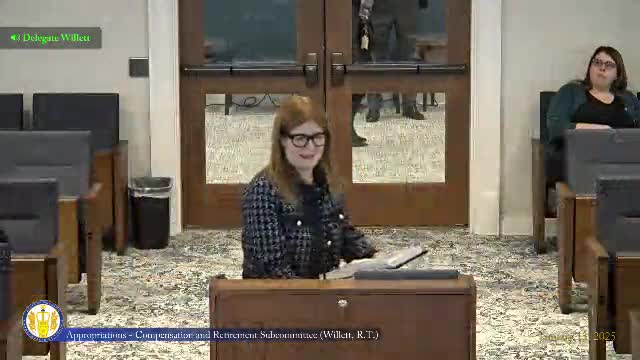VRS funded status improves but $20 billion in liabilities remain; hybrid plan participation low
January 13, 2025 | 2025 Legislature VA, Virginia
This article was created by AI summarizing key points discussed. AI makes mistakes, so for full details and context, please refer to the video of the full meeting. Please report any errors so we can fix them. Report an error »

Trish Bishop, director of the Virginia Retirement System, told the Tarver subcommittee that VRS’s funded status has improved — about 82.1% for the state‑employee plan and about 83% for the teacher plan — but that roughly $20 billion in unfunded liabilities remain across all plans.
Bishop said the VRS trust reached about $114,000,000,000 at fiscal‑year 2024 year‑end and that investment income funds about two‑thirds of benefits. She reported a 9.9% net return for fiscal 2024 and noted the system uses a 6.75% long‑term assumed rate of return (discount rate) to value liabilities.
Why this matters: Funded status, discount rates and investment returns affect employer contribution rates, budget planning for the Commonwealth and the system’s standing with bond raters.
Bishop summarized plan health and employer contributions, saying actuarial valuations are done annually but rates are set biennially. She said contribution rates appear generally stable in the near term given recent infusions and maintained higher contribution levels but stressed the unfunded liabilities persist. "We take this job very seriously," Bishop said.
Bishop gave detailed figures: about $5.4 billion in unfunded liabilities (market value basis) remain in the state employee plan and about $10.7 billion remain in the teacher plan. Across pension plans she reported roughly $20 billion in unfunded liabilities. She also said other post‑employment benefits (OPEB) are less well funded, noting the teacher health‑insurance‑credit and state employee health‑insurance‑credit are funded at roughly 22% and 35–36%, respectively.
On the hybrid retirement plan, Bishop said the hybrid is now the largest active member group but that voluntary participation is low. She reported 33–36% of hybrid participants in the surveyed groups make no voluntary contributions; about 28% make the maximum. Auto‑escalation is currently set to increase voluntary contributions every three years by 0.5 percentage points, which Bishop observed would require roughly 27 years to reach the full recommended voluntary contribution via escalation alone. She said automatic features and education are tools to raise participation.
Bishop described options considered for the Judicial Retirement System (JRS), which now enrolls new judges in the hybrid plan. Options included increasing the defined‑contribution employer match, adjusting multipliers for judges appointed at older ages, using larger service‑weighting factors, or prospectively moving judges into Plan 2. Bishop said modifications focused on the defined‑contribution side carry lower administrative and risk impacts than changes to defined‑benefit formulas; estimated additional costs she presented ranged from roughly $1 million to about $4 million (initial, varying by option) and would increase as newly hired judges enter the plan.
Bishop also announced a record‑keeper transition for VRS defined‑contribution accounts: Voya replaced MissionSquare effective Jan. 1; she said about 643,000 accounts (roughly 350,000 unique participants and about $8.7 billion in assets) moved to Voya and that VRS retains control of the investment lineup.
The presentation closed with Bishop taking questions from committee members about participation, membership and next steps for plan design discussions.
Bishop said the VRS trust reached about $114,000,000,000 at fiscal‑year 2024 year‑end and that investment income funds about two‑thirds of benefits. She reported a 9.9% net return for fiscal 2024 and noted the system uses a 6.75% long‑term assumed rate of return (discount rate) to value liabilities.
Why this matters: Funded status, discount rates and investment returns affect employer contribution rates, budget planning for the Commonwealth and the system’s standing with bond raters.
Bishop summarized plan health and employer contributions, saying actuarial valuations are done annually but rates are set biennially. She said contribution rates appear generally stable in the near term given recent infusions and maintained higher contribution levels but stressed the unfunded liabilities persist. "We take this job very seriously," Bishop said.
Bishop gave detailed figures: about $5.4 billion in unfunded liabilities (market value basis) remain in the state employee plan and about $10.7 billion remain in the teacher plan. Across pension plans she reported roughly $20 billion in unfunded liabilities. She also said other post‑employment benefits (OPEB) are less well funded, noting the teacher health‑insurance‑credit and state employee health‑insurance‑credit are funded at roughly 22% and 35–36%, respectively.
On the hybrid retirement plan, Bishop said the hybrid is now the largest active member group but that voluntary participation is low. She reported 33–36% of hybrid participants in the surveyed groups make no voluntary contributions; about 28% make the maximum. Auto‑escalation is currently set to increase voluntary contributions every three years by 0.5 percentage points, which Bishop observed would require roughly 27 years to reach the full recommended voluntary contribution via escalation alone. She said automatic features and education are tools to raise participation.
Bishop described options considered for the Judicial Retirement System (JRS), which now enrolls new judges in the hybrid plan. Options included increasing the defined‑contribution employer match, adjusting multipliers for judges appointed at older ages, using larger service‑weighting factors, or prospectively moving judges into Plan 2. Bishop said modifications focused on the defined‑contribution side carry lower administrative and risk impacts than changes to defined‑benefit formulas; estimated additional costs she presented ranged from roughly $1 million to about $4 million (initial, varying by option) and would increase as newly hired judges enter the plan.
Bishop also announced a record‑keeper transition for VRS defined‑contribution accounts: Voya replaced MissionSquare effective Jan. 1; she said about 643,000 accounts (roughly 350,000 unique participants and about $8.7 billion in assets) moved to Voya and that VRS retains control of the investment lineup.
The presentation closed with Bishop taking questions from committee members about participation, membership and next steps for plan design discussions.
View full meeting
This article is based on a recent meeting—watch the full video and explore the complete transcript for deeper insights into the discussion.
View full meeting
